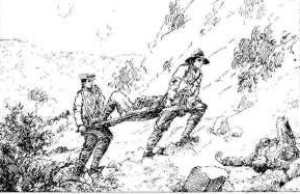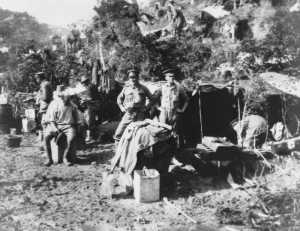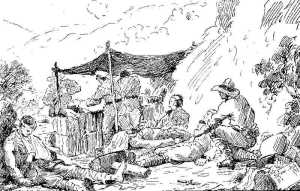By mid-morning on April 26th stretchers had become a scarce and precious commodity at ANZAC. Used to carry the wounded and taken out with them to the ships they mostly weren’t being returned, forcing the bearers to improvise. The wounded were being carried over men’s shoulders. For those seriously wounded in the chest or abdomen etc this of course wasn’t possible. Then groundsheets had to be used. Lieut. Tom Chataway remembered this experience well. “The transportation of the wounded to the beach was in itself a nightmare”, he writes, “even when stretchers were used. But (where stretchers were not available) oil sheets had to be used. Then (for the bearers) - slipping and sliding down the steep hillside, their hands cramping from the insecure hold upon the corners of the sheet, the heavy shrapnel fire continuously above them, and a persistent urge to halt - if only for a few seconds so as to ease the cramp in their hands -made the journey one long agony.”

An ANZAC carries a wounded mate to the nearest dressing station, for treatment (Australian War Memorial G00599).

Sketch by Ellis Silas, 16th Battalion, ‘Stretcher-bearers in action at the head of Monash Valley.’
With four-man stretcher squads (as the bearers had been taught to operate and would again in later months), with one man on each end of a stretcher pole, bearing the weight of a wounded man hoisted up on his shoulder, a team could carry their burden for considerable distances without becoming exhausted - “for miles”, according to Bert Baker. But a two-man squad was an entirely different matter. Then the work was cruel. Then the man at either end of the stretcher had to rely entirely on the strength of his arms, shoulders, stomach and back muscles. “You could only carry for about a hundred (metres) at a time, before you had to stop for a rest, before going on,” Bert remembered. Fortunately the distances at ANZAC were comparatively short. But this was more than compensated for by the savage terrain and vegetation which the men had to fight their way through or around.
During the morning hours of April 26th Jack did what many of his mates were doing - carried casualties back to the beach over his shoulder - until he was stopped dead in his tracks by something he saw; something he’d been passing for hours, but in common with the rest of his mates had paid little attention to.
A number of donkeys had been landed, along with their Greek drivers, to carry kerosene tins of water for the troops. Some of these donkeys had been abandoned by their drivers and now sought shelter and what little grazing there was in amongst the wild overgrown gullies. Jack was responding to a call of - “Stretcher-Bearer!” - when he saw, grazing unconcernedly near the wounded man, a donkey.
As he approached closer no doubt there suddenly appeared in Jack’s mind another picture - one all too familiar, and from his not-too-distant past. Sitting on the back of that funny little long-eared creature he would have seen - a child, laughing and care-free as he was being led along the sands, with Jack walking along next to the donkey, looking back at him over his shoulder every now and again. But if a child Jack must have thought - then why not a man! Of course! It was the perfect answer.
Jack had none of the essential equipment he needed - but he did have a pocketful of field dressings. They’d have to do for the time being. He knew that once he got his hands on the necessary materials he’d be able to fashion something much more substantial and appropriate.
A portion of one bandage served as a primitive “head-stall”. Then a first field dressing provided him with a “lead rope”. There was no way in the world his passenger was going to be able to stay on the donkey’s back by his own efforts - with no saddle, stirrups, reins or anything else to hang on to. He’d just have to hang on to Jack, as this donkey-man carefully guided his little beast of burden along. Jack lifted his passenger aboard, then, sufficiently equipped for the moment, set off for the beach, on his first donkey-ride, and on his new career.
During the first days at ANZAC the field ambulance bearers and the regimental stretcher-bearers were forced into doing very much the same work, in the confused conditions and hectic fighting. Regimental bearers were infantrymen, specially trained by their regimental medical officer in first aid. Their job was to carry their wounded mates off the battlefield for immediate treatment at a nearby aid post. When they put down their rifles and picked up a stretcher they were entitled to put on an armband (for protection from the enemy) bearing the letters “SB”. Field ambulance bearers, on the other hand, were members of the Medical Corps, and wore the Red-Cross armband. Their job was to carry the more seriously wounded from the regimental aid post to a field ambulance dressing station, for more expert medical attention.
A regimental aid post could be, and often was a very makeshift affair (as it might well be of a temporary nature). It could be located in a ditch, or in a shell hole, covered over with a tarpaulin “roof”, or in an improvised dugout; or in a cellar, or an abandoned building -anywhere which provided shelter and protection from enemy fire.
Dressing stations, on the other hand, were supposed to be relatively secure, at least two to five kilometres from the front line, and at the very least under canvas. At ANZAC the medical services available during this first week were primitive in the extreme.
During these first days Jack had to rescue his casualties off the battle-field, sometimes in clear sight of the enemy. In 1915 E.C. Buley collected a number of eye-witness accounts from wounded ANZACs in hospital, of Jack at work. In Buley’s words:
When the enfilading fire down the valley was at its worst and orders were posted that the ambulancemen must not go out, the Man and the Donkey continued on placidly at their work. At times they held trenches of hundreds of men spellbound, just to see them at their work. Their quarry lay motionless in an open patch, in easy reach of a dozen Turkish rifles. Patiently the little donkey waited under cover, while the man crawled through the thick scrub until he got within striking distance. Then a lightning dash, and he had the wounded man on his back and was making for cover again. In those fierce seconds he always seemed to bear a charmed life. Once under cover he tended his charge with quick, skilful movements.
Jack would then have administered the emergency first aid treatment which was second nature to all stretcher-bearers. First, the first field dressing (which every soldier carried as part of his equipment) would be taken out of the man’s right hand tunic pocket. Or Jack might well have used one from his own supply. This consisted of “a khaki cotton cloth containing in a linen cover two dressings, each composed of 2 1/2 metres of bandage, some gauze and a safety pin.” Jack would have torn open the soldier’s uniform to get to the wound. Next, the iodine ampoule which every soldier carried would have been taken out of its hard cardboard, cylindrical container. Jack would have snapped the end off the ampoule, soaked a cotton wool plug with iodine and applied this to the wound. Then the dressing would have been applied and the wound bandaged up. If required Jack would have applied a tourniquet, improvised if necessary, using a handkerchief, a stick and a stone - to stop uncontrollable bleeding. Tourniquets would have to be released every twenty minutes to prevent gangrene.
Within a few days of the landing a kind of order was being established. On April 29th zones of responsibility were laid down, with the 3rd and 4th Field Ambulances responsible for clearing casualties from the head of Monash Valley, and the wounded of the 4th Brigade (the 13th, 14th, 15th and 16th Battalions) on Pope’s Hill and at Quinn’s and Courtney’s Posts.
Jack and his mates carried their casualties down the “Long Valley”, of Monash Valley and Shrapnel Gully (as it was known then) to the clearing hospital on the beach. The distance was about twelve hundred metres. Using his donkey and working all day and halfway into the night Jack could make between twelve and fifteen trips a day. The two-way trips took about an hour, and this still left Jack time for a mug of tea and a chat with his mates at the cove after dropping off his casualty at the clearing station.

The Advanced Dressing Station of the 4th Field Ambulance at the head of Monash Valley, below Pope’s Hill - an early photo. It was from here Jack collected most of his casualties after the first week. (Australian War Memorial A02693).

Walking wounded going past 3rd Battalion Aid Post in Shrapnel Gully on April 26th. (Australian War Memorial G00920).

Ellis Silas’ impression of the dressing station at the head of Monash Valley during the first days at ANZAC.
The other two-man stretcher teams were hard pressed to make six trips a day down the valley. Cpl. E.H. Kitson, a stretcher-bearer with the 4th Field Ambulance, made the same trip as Jack daily, and he has left a detailed description:
Many snipers being in the hills made the carry down the gullies rather unhealthy. For the first fortnight or so the carry from Quinn’s to the beach was beset with all sorts of inconceivable difficulties. The carry... had to be done without reliefs over a very muddy and narrow track. At various places... it was necessary to sprint past these warm points, from one safe place to another, as snipers were very diligent and accurate, and shrapnel was also uncomfortably plentiful. We had at times to assist the regimental bearers in answer to oft repeated calls from the hills - “Stretcher Bearers wanted on the left, or right!” as the case might be... After the first fortnight however conditions began to improve by widening of the track and protecting the same by building sandbag barricades at exposed points and by the construction of dug-outs, mainly consisting of holes dug into the side of the hills.
Jack used a number of donkeys, which he called by a variety of names: Murphy, Abdul - even Queen Elizabeth. But his favourite name was Duffy. Andy described how Jack’s career had begun on that second day: “The original order was amended to two men (to a stretcher) as the bearer numbers were badly depleted. The hard fighting throughout the day caused heavy casualties, until the bearers had inadequate means to do their work. The shortage of stretchers was relieved in a measure by improvised equipment sent ashore by the warships. But the need was still so great that it inspired (Simpson) to commandeer a stray donkey, which he named Duffy.”
Capt. Victor Conrick added: “At the landing, April 25th 1915, he went ashore with his bearer squad of four; his three mates were either killed or wounded and Simpson was left alone.”
Jack only carried men wounded in the leg (and some head wounds); that is, men who could sit astride a donkey with assistance. He left the serious chest and abdomen wounds, those who had to be stretchered down to the beach, to the scant resources of the two-man bearer squads available. Colonel Monash fully recognised the value of Jack’s self-imposed role, stating that “Simpson was worth a hundred men to me.”
From April 26th Jack “ran his own casualty carrying service” (in the words of Andy Davidson), refusing to go back to his own unit at the end of each day’s work along with his mates. He knew what he had to do, and nobody was going to stop him. Jack knew that he could rescue many more casualties using a donkey, than as part of a stretcher team. He had a natural way with animals, especially donkeys. But he also knew that he was very soon going to find himself in trouble with the authorities, because what he was doing simply wasn’t a part of army regulations.





